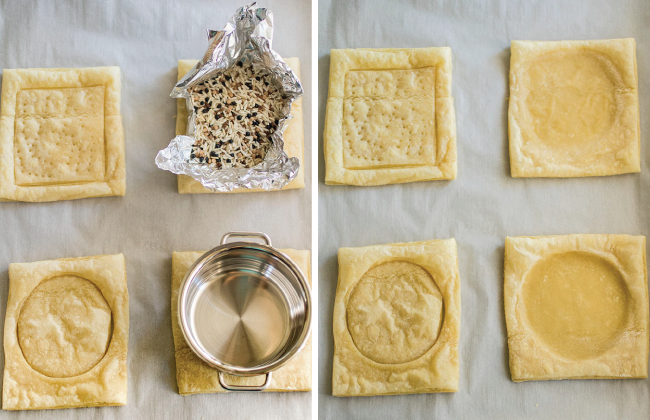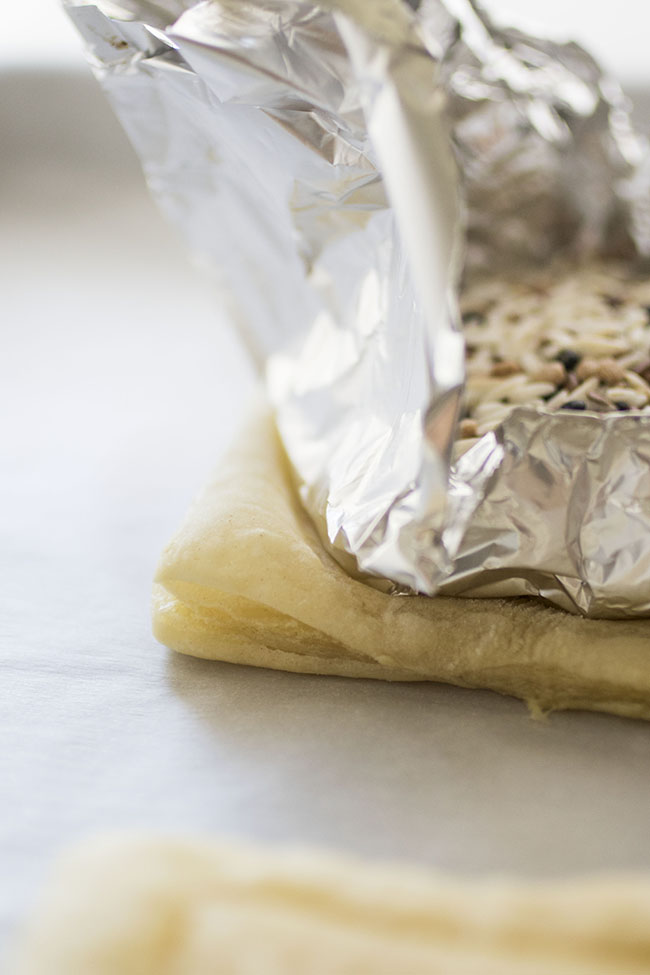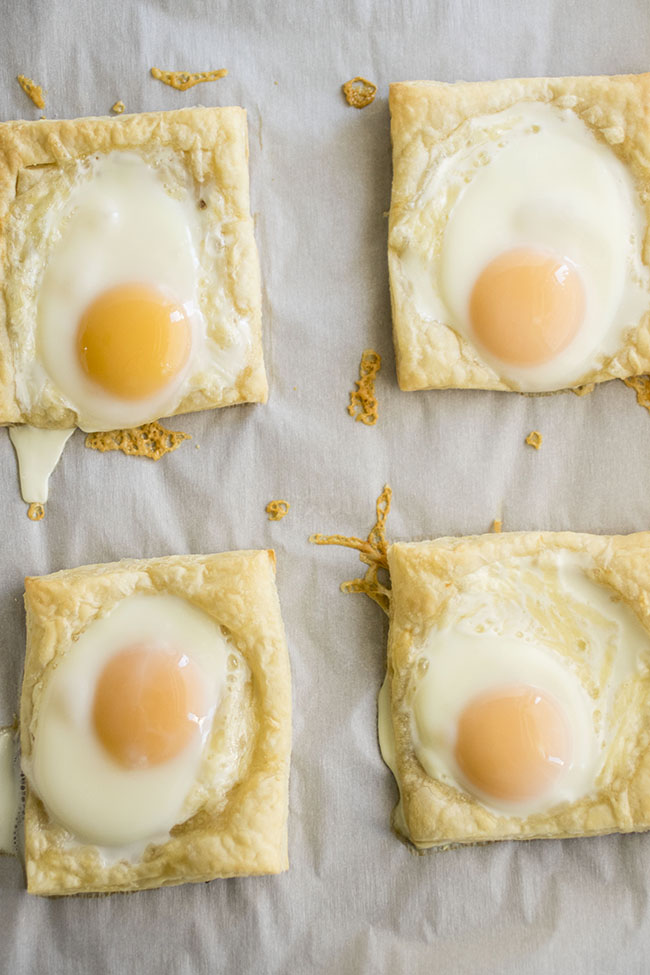EASY PUFF PASTRY BAKED EGGS BREAKFAST IDEAS
This puff pastry baked eggs recipe is easy enough for busy mornings and elegant enough for a Sunday brunch! Includes how-to steps and photos so you can get the eggs to stay in place.
This post contains affiliate links, which means if you purchase something I’ll earn a small commission at no extra cost to you.

Friends of the internet! I present to youuuuuu: The easiest brunch recipe ever that will make everyone think you’re super impressive but is actually secretly super simple and could totally be made before work on a busy morning.

Also, an experiment!
I feel like whenever I see an eggs-in-puff-pastry recipe, they (that’d the royal “they” of the interwebs, obvs) tell you to SCORE the puff pastry and then prick the inside of the score-part (for those who somehow didn’t understand that completely and totally helpful description, please keep reading because there’s a picture) because SCORING will somehow make the puff pastry rise differently and help egg stay where it’s supposed to?
But, umm, I’ve tried that.
And it has never really worked for me.
And I’m pretty sure it’s a big fat internet lie. (That, or I’m a lot less food-savvy than I’d like to think I am. But we’re going to go with INTERNET LIE!)
SO. In search of the perfect puff-pastry hack, I tried a few different things to help us 1) Keep the eggs where they’re supposed to be for BAKED EGG WORLD DOMINATION and 2) maintain our sanity without throwing trays of failed puff pastry at the wall because ARGH.
Let’s see how it turned out! (OMG SUSPENSE)
THE PUFF PASTRY BAKED EGGS EXPERIMENT:
The idea here is to parbake (or pre-bake) the puff pastry just enough for the edges to rise but still leave a nice dent in the middle, so that you can easily tip the egg into the dent and then pop the whole thing back in the oven to finish baking.
On the top left (see picture below), I’ve used the internet conspiracy of liesfrequently-suggested technique of scoring the puff pastry to create a border, and then pricking the interior piece with a fork.
I also used a rice-filled foil packet (top right) as a weight, a cutout-and-layer situation (bottom left) and finally a small baking dish as a weight (bottom right). I used this Cuisinart mini dutch oven, but other good options are this mini casserole dish, an enamel dutch oven, or standard baking ramekins.

If you’re curious about that circle-y one on the bottom left, all I did was cut out a round from the puff pastry piece, stretch the round out a little bit, and then lay the border piece over the round piece:
THE RESULTS:
I baked all of the puff pastry at 400 degrees F for about 6 minutes (the same directions you’ll follow for this recipe!) and here’s what we ended up with:

As you can probably tell, the two techniques on the right left us with the most well-defined “pockets” for our eggs.
The score-and-prick method (top left) ended up the same height across the whole pastry piece, which isn’t ideal for creating a barrier to keep the egg from slipping out. My super-brainiac cutout piece (bottom left) was a straight FAIL – the pastry didn’t stay together so it ended up with gaps that let the egg slip between the layers, and the middle piece still rose quite a bit.
Both the puff pastry pieces that were weighted – one with the rice packet, one with the baking dish – had more defined pockets, and the edges had started to puff up nicely around the weights as you can see below (remember that the pastry isn’t fully baked yet):


The only difference with the weighted pieces is that the pastry didn’t rise and flake as much under the weights as it did around the edges during that first baking time – but honestly, once you’ve added the eggs and baked the whole thing off, you won’t even notice a difference.
The winner, in my book, was the puff pastry that used a small baking dish(you could also use a ramekin) as a weight.
Just look how perfectly the egg fits in that little pocket – even with some cheese in the mix!

Ahhhhhhh, perfection.
For funsies, let’s see how the rest of our experimental puff pastry pieces baked up once we added an egg:

The baking-dish/ramekin-weighted pastry piece (bottom right) kept our egg pretty much right where we put it (HUZZAH), but you’ll notice the rest of them slid around a little bit (although the rice and foil weighted piece also kept its egg from spilling all over the place like the two on the left!)

Now that we know how to get those finicky eggs to stay where we put them (TEN POINTS TO GRYFFINDOR), should we talk about the rest of this recipe? Yes? Ok.

I kept this dish craaaaazy simple. Just some cheese (that’d be sharp white cheddar + parmesan), salt, pepper, and parsley are all you need here. The richness of the puff pastry and that golden egg yolk are perfect on their own with just a bit of sharp cheese and some fresh herbs.

To make it a little heartier, add bacon or breakfast sausage, tomatoes, bell peppers, or any other herbs you have lying around! You could also skip the individual servings and bake this on one big sheet of puff pastry for a tart-style dish.
EASY PUFF PASTRY BAKED EGGS

Ingredients
- 1 sheet puff pastry, defrosted and cut into 4 squares (my squares were about 4″)
- 1/3 cup shredded white cheddar cheese
- 4 eggs
- salt and pepper to taste
- 1/3 cup grated parmesan cheese
- 1/3 cup chopped fresh parsley
INSTRUCTIONS
- Line a large baking sheet with parchment paper and heat the oven to 400 degrees F.
- Lay puff pastry squares out on the parchment, leaving an inch or so of space between each one. Place a small oven-safe baking dish in the center of each puff pastry square.
- Bake puff pastry with the ramekin weights for 6-7 minutes until pastry has puffed up around the edges of each ramekin but not yet begun to brown.
- Remove puff pastry tray from oven and remove ramekins. You should be left with a nice indent in each puff pastry piece – this is where the egg will go!
- Sprinkle a bit of shredded cheddar cheese over each puff pastry square, then crack one egg into the indent of each square.
- Return tray to oven for another 12-14 minutes until eggs have set and puff pastry has lightly browned. (If you like your eggs well done, you may need to extend the cooking time).
- Top baked eggs with salt, pepper, a dusting of parmesan cheese, and a sprinkle of fresh parsley. Serve immediately.
NOTES
If you don’t have ramekins, you can form a small “bowl” out of foil and weight it down with pie weights, beans, or rice. See the post itself for more information about this recipe’s puff pastry experiment!
Make sure the puff pastry is on a flat surface when you add the eggs, otherwise they might not want to stay where you put them.
Add bacon, alternate cheeses, or additional veggies to these baked eggs – they’re a great blank canvas food and can be easily customized depending on what you’ve got lying around!
Source Article : Click here


0 Response to "EASY PUFF PASTRY BAKED EGGS BREAKFAST IDEAS"
Post a Comment